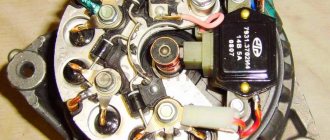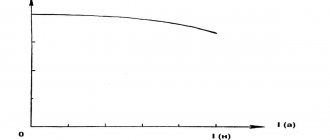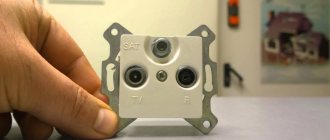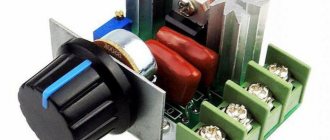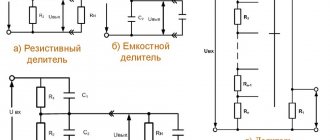Security measures
The main danger when working with a generator is its direct connection to the electrical network.
Do not connect directly to an outlet. This can lead to an increase in current in those sections of the circuit that are not designed for such an increase. The cross-section of the cable must also be taken into account, as well as the uniformity of load distribution in the premises. When the generator is connected directly to an outlet, the cable insulation is destroyed, premature wear occurs and the conductors burn out. Therefore, there are several basic ways to properly connect the device.
Types of electric generator models
Currently, there are a number of types of electrical generators. Among them:
Asynchronous units. Due to the simplicity and reliability of the design, these systems are in great demand. Important components are securely hidden from moisture and dust. It is reasonable to use them when performing complex tasks and intensive loads. The asynchronous type should not be used as power supply for electric motors; Synchronous. The disadvantages characteristic of the previous type are absent here. Also, synchronous models are able to maintain a more accurate voltage
When choosing, you should pay attention to brushless designs, which have better current quality and the absence of intense radio interference; Inverter models are expensive and have relatively low power. Single-phase devices are not popular due to low performance
In turn, three-phase models are much better. Among the disadvantages of inverter models are the expensive cost of equipment and poor performance properties;
Single-phase and three-phase generators
It is necessary to connect three-phase generators only in cases where an uninterruptible power supply system is used as the only source of electrical energy. In all other cases, it is much wiser to opt for the 1-phase option. Three-phase models are many times more expensive than single-phase ones, but in order to connect a single-phase generator to a three-phase network, you do not need to be an experienced electrician.
It is enough to choose a model that is relatively simple in terms of design features, which will allow you to rationally distribute the power of the equipment. 3-phase systems are not in great demand due to the lack of normal load distribution. To avoid overheating, short circuits and other negative consequences, such installations must be configured correctly. If the permissible load is exceeded by 25 percent, the system will quickly fail.
If we are talking about arranging a backup source of electrical power, it is much more reasonable to use a single-phase generator.
Choice
The buyer must determine from the very beginning which technical parameters are the most important for him. It is worth taking a closer look at these indicators:
- Weight.
- Dimensions.
- Power.
- Fuel consumption.
- Noise level.
- Duration of work.
Automation and price are parameters that are also being looked at. This is important for those who are interested in how to connect a generator to the home network, the diagram of which is posted on specialized websites.
Generator operation
By parameters
Many people first look for an answer to the question of how many phases a generator should have for maximum convenient operation. To do this, you need to understand what electrical appliances will be connected. Three-phase options allow connection to both single- and three-phase devices. Single-phase ones are combined with only one type of consumer. But this does not mean that models with more phases will be better under all circumstances.
At each phase, the maximum load should be no more than 30%. This means that in reality the owners will not be able to use more than a third of the rated power that the outlet initially has. For example, the rated power of a three-phase generator is 6 kW. This means that no more than 2 kW can be removed from a regular 220 V outlet. The load still needs to be distributed over several phases when connecting a single-phase generator to a three-phase network at home.
You may be interested in this Surge protector for household appliances and computers
Note! For power, they also check the parameters of the devices that are planned to be connected. It is important to have a reserve of at least 20-30%. Otherwise, you may encounter problems such as overload and work stoppage. Too much fuel will also be consumed.
Connection work
Type
Synchronous and asynchronous types of devices are available. The choice involves a careful study of the characteristics of each of the existing models.
Network device
Asynchronous
Their main problem is their inability to handle so-called peak loads. Although these devices can also be used to maintain normal voltage readings. They are suitable for joint use with equipment sensitive to voltage surges:
- Electronic devices.
- Computer Engineering.
- Medical devices supporting gasoline generators.
Residual magnetization of the rotor is the main source of energy for such devices. Therefore, the service life of asynchronous generators is longer than that of their closest analogues. They do not require the use of cooling systems; the unit housing is completely closed. Thanks to this, protection from dust and moisture is fully guaranteed.
Interesting! The asynchronous generator is immune to short circuits. Therefore, this energy source is the optimal solution for welding machines. But such devices can be very sensitive to overloads. Therefore, it is prohibited to connect them to devices with initially high inrush currents.
Devices with autostart
Synchronous
The quality of the current in this case is lower when compared with the previous option. Suitable for providing emergency power in various circumstances:
- Offices.
- Refrigeration units.
- Electrical equipment in dachas and country houses.
- Construction projects.
Such devices also have some positive qualities:
- Resistance to short-term overloads.
- Ability to normally withstand peak loads, including mechanical loads.
But protection from moisture, dust and dirt is worse than that of asynchronous structures. After all, in order to cool, such generators need to pass a certain amount of air through themselves. A synchronous generator will be needed if devices operating with reactive loads are used. Then the power will be less.
Changeover switches
Phasing
It has already been mentioned above. It is worth buying three-phase generators only if there is a consumer with the appropriate characteristics in the house. If all the devices are single-phase, then the generator is selected of this type. This even applies to situations where there is a three-phase network connected to the house.
Network connection
Autostart gas generator
Having some skills in electrical engineering, the owner of a private home can easily install a circuit with his own hands that will ensure autostart and inclusion of the gas generator in the home network. The only condition is to select a generator model that can be started and stopped using a key, since automating the start of a generator with an engine started by a kick starter is a very troublesome and thankless task.
The idea of how such a scheme works can be expressed in 3 points:
- A couple of minutes after turning off the power supply from the power line, it is necessary to close the air damper in the engine and start the engine itself. The time delay is necessary to be on the safe side in situations where the light goes out for only a few seconds.
- Another two minutes after the device’s engine warms up, open the air damper and redirect the load from the external line to the backup line (from the generator).
- When mains power is restored after 60 seconds, switch the load back to the main line and stop the generator engine.
At the moment the voltage in the main line disappears, the starter coils connected to the main network will no longer hold the contacts that turn on the starter ignition in the open state, and the power contacts of the main line in the closed state. This will lead to the ignition in the gas generator being turned on and the home network being disconnected from the external line.
At the same time, the normally closed contacts will be closed. This will activate the magnetic pusher that closes the air damper and send an impulse to the time relay responsible for starting the engine. After a minute, the starter will start the gas generator engine.
After the generator starts, the coil responsible for stopping the starter will operate. Simultaneously with these events, a signal will be sent to a temporary relay responsible for the electric current from the backup network, which will lead, after 120 seconds, to the opening of the engine air damper and the flow of electric current from the generator to the home network.
Turning off the electric generator and returning to power from the main line is provided by another pair of contactors and a time relay.
When performing such work, you must have certain knowledge of how to correctly create a diagram for connecting a generator to the home network, as well as installation skills. And if there is no such practice and confidence, then it is best to trust specialists in such situations.
Necessary equipment
To technically correctly connect the generator to the home network, you do not need many devices. Here are just a few of the requirements that must be met:
Connecting the generator to the house
- Providing separate input. It is recommended to choose copper wires with a cross-section of at least 4 mm2 for this purpose. They are laid starting from the input distribution device and ending with a specially equipped installation site.
- Changeover switch. Recently, a large number of similar devices have appeared that can be used for personal needs. The main thing is to choose mounting on a 35 mm DIN rail; this is one of the most universal solutions. TDM-63 is an example of the cheapest brands. But there are better and more reliable devices - E200 from ABB, SFB from Hagger. Manufacturers themselves often write instructions describing how to connect the generator to the home network. .
Important! The switching and connection scheme for most devices is universal and simple. The common bus of outgoing loads is often connected to the lower part. Two separate inputs are connected on the reverse side, where the paired contacts are. The control key has three positions in general. The circuits are open when it is medium. Any manufacturers now allow the production of multi-pole devices. This makes it easier to work with three-phase networks, grounding or grounding systems of increased complexity.
A three-position or changeover switch has a main principle - a load switch. This leads to the fact that the design does not initially provide for a thermal or electromagnetic release. Each input requires additional protection using a machine. The maximum current for the latter is determined based on the permissible load along the supply line. It doesn't matter which bus the connection is made to.
A pair of two-pole circuit breakers can be used to independently manufacture the simplest version of changeover devices. You just need to follow a few simple steps:
- Place the devices nearby.
- One is turned upside down.
- Then the keys are connected together, for which a steel pin is inserted into the standard hole. The rule is relevant for any type of electric current generator .
Connecting devices to the network
Using a changeover switch
The easiest way to connect the power plant to the home network is through a switch or a three-way reversing switch. The difference between the devices is that the switch is installed separately near the panel, and the switch can be mounted on a DIN rail, which is more convenient.
So, first, look at the diagram on how to connect a single-phase generator to a private house:
Installation via a switch
As you can see, you need to connect power from the mains to the switch at the top, and a cable from the power plant at the bottom. The middle contacts are designed to connect electricity consumers
We draw your attention to the fact that the switch or breaker must be located after the meter, but before the input machines, as will be shown in the diagram below (with ATS)
As for the connection technology, it looks like this:
- Turn off the power supply in the house (circuit breakers on the panel).
- Connect the wires according to the diagram.
- Start the generator and wait for it to warm up for a few minutes.
- Switch the switch to the power supply position from the power plant (according to the rules - lower).
When the power supply is restored at the site, you must first return the switch to the upper position, and then turn off the generator.
How to connect a generator to a three-phase network at home?
- How to connect a single-phase generator?
- Auto switching circuit
- Via socket
- Important Rules
A backup source of electrical energy will never be superfluous in a country house in case of emergency. Unplanned, permanent or accident-related power outages can negatively impact electrical appliances. And when your heating system is dependent on the supply of electricity, then in winter there is a danger that the home will cool down and its owner will freeze.
Installation of an AVR unit with automatic start of a gas generator
In light of the above, a device that generally eliminates human intervention in the operation of the emergency power supply system would be very useful. There really are such devices and they work completely uninterrupted, but only with generators equipped with an electric starter and a standard stopping system.
Developing such a system on your own is a troublesome task, worthy of separate discussion. If the work is not organized correctly, there is a high risk of damaging the equipment. For example, if the generator has a breakdown in the motor part, its forced repeated starting will cause, at the very least, a deep discharge of the battery, and in the worst case, will lead to failure of the electric starter windings.
We advise you to study - Which is better, a convector or an oil heater - comparison of characteristics
There are two options for such devices, the first is a standard electronic control unit, supplied with the generator and installed with it in the same room. Such a unit is connected according to the diagram included in the instructions and it only controls starting and stopping the engine, in some cases it takes on the task of adjusting the speed and output power. The main switching of the reserve input is performed by contactors according to the scheme that we described earlier. Only in this case, a normally open contact on the main input is extended with a low-current signal wire to the control unit so that the current state of the city line makes it clear to the electronics when the generator should be started or stopped.
1 - automatic generator start block; 2 — main input contactor; 3 - backup input contactor
The second option is complete ATS devices with autostart. This is not a very wide range of devices, but they all require the installation of additional equipment on the generator: an electric throttle drive and a starter with a battery.
Connecting the generator via an automatic transfer switch: 1 - input circuit breaker; 2 - counter; 3 — AVR shield; 4 - generator; 5 - control cable; 6 - zero bus; 7 — consumer machines; 8 - ground bus
The advantage of such systems is that they have everything you need out of the box and completely replace the input distribution device, including built-in current protection, and sometimes even have a surge and leakage protection system. All you need to connect is to connect the input cores and consumer buses to the switching devices, and also connect the secondary terminal block to additional generator equipment using a four- or five-core wire.
Generator selection
Determining the power of a generator does not mean deciding on the choice of generator. There are several criteria that need to be considered during the purchase. Among them are:
- number of phases;
- form factor;
- fuel used;
- launch method;
- presence of a voltage stabilizer.
The number of phases that will be used in the generator depends on how many phases come from the main power supply. There is no problem in supplying only one phase, but there will be too much load on the wiring. Also, only part of the equipment will work, and the rest will require extension cords. It is worth understanding that three-phase generators will cost slightly more than single-phase ones. The generator can be transportable or stationary. There are stationary options that are designed for very heavy loads. Mobile ones have slightly less potential, but they can be used not only at home.
Depending on the fuel used, generators can be:
- gasoline;
- gas;
- diesel;
- dual fuel.
The choice of source will depend on what is most available in a particular area. Gasoline generators are widely used. Gas generators can operate on mains and liquefied gas. There are dual-fuel options that can operate on gasoline and gas. Diesel generators are considered the most economical. But they are not as easy to maintain as the previous ones.
Note! If you plan to connect the generator to the gas main, then project preparation will be required. Otherwise, you can get heavy fines for illegal tapping.
Based on the type of start-up, generators can be divided into:
- manual;
- with electric starter.
If an automatic starting system is planned, then the second option will be required. The generator may have additional functions. One of them is a voltage stabilizer. The module monitors that the output is stable 220 volts in the case of a single-phase connection. If a stabilizer is already installed in the house, then there is no point in overpaying for this function. There is a separate 12 volt output for starting the corresponding consumers. It is worth understanding that most generators produce voltage with an alternative sine wave. Some consumers require the correct sine wave, if the house does not have a separate converter, then it is necessary to select a generator with the correct sine wave.
Connection with partial use of automation
Another way is to connect simple automation. The operating principle of such a system is relatively simple.
If the centralized power supply disappears, you need to start a gas generator. If there is no energy in the general network, the contactor of the electric generator closes. When centralized power supply appears, the contactor will open.
The AVR can be modified independently. In some cases, a time relay is additionally built in. In this case, when starting a gasoline electric unit, the full load will be turned on only after some time, during which the electric generator warms up, stabilizes the speed and switches to the operating mode.
In a similar way, you can either connect a manually started gas generator to the home network or use an electric generator with an electric starter.
Schemes for connecting via an outlet to a home network
There are several key methods for connecting generators through an outlet.
- Connecting a backup power source to a dedicated group of consumers according to a separate, pre-created circuit;
- Using a changeover switch or a three-position switch, where jumpers are made at the input from the generator side. This method will allow you to properly power your entire home network. The main disadvantage of the design is the impossibility of using three-phase generators;
- The use of two contactors, where one acts as an adapter from the city network, and the other serves as a bridge from the backup source. The method is in great demand when using autostart systems. When choosing it, you need to take care of the jumpers between the inputs on the reserve side;
When connecting a three-phase installation to a three-phase network, you must first equip the appropriate electrical receivers, for example, motors of electrical machines.
When installing a backup power source in a country house or country house, you must correctly assess your capabilities and be responsible in choosing the appropriate solution. In this case, the purchase will meet all your expectations and become productive.
Generator connection methods
Manual
The corresponding devices are available in two versions - a changeover switch (old model) or a reversing switch (three-way). The first option is worse from a safety point of view, since this model often sparks, and all live parts are exposed. Therefore, you will definitely need a protective casing (box, drawer or something similar), and installing a switch in the house is probably only possible in the utility room. It is unlikely that it will decorate a living space.
But the switch is both more compact and safer. It can be mounted on a DIN rail and placed in a power cabinet, next to the AV and RCD.
Plus - low cost of products and a minimum of connections.
The downside is that such a connection is justified only if someone is constantly in the house. A switch is a manually operated device. A situation familiar to many - everyone went on business (to work, school), and the power engineers turned off the lights. The result is puddles under the refrigerator, a switched off boiler and cold batteries. The list could take a long time.
What to take into account - these devices are always connected to the network before the input machines, but after the electric meter.
How to check the functionality of the circuit:
- Start and warm up the backup power source (generator).
- Make a switch.
Auto
The expediency of just such a connection of the generator to the power grid does not require explanation. The circuit is somewhat inert, but this is not critical.
How does it work? The auto start system (ATS) constantly, as it is now fashionable to say, “monitors” the presence of voltage. When it disappears, the contact group connected to the network opens. At the same time, the generator starter is turned on and the engine starts automatically.
We advise you to study - How to choose a generator for your home: selection of optimal equipment parameters
After it enters the ATS mode, it closes the “backup source - home network” circuit. When the industrial/voltage is restored, everything happens in the reverse order, and without the intervention of the owner, automatically. For a private home - the optimal solution for organizing power supplies.
The author considers it pointless to explain which wire and which contacts to connect to. There are several ATS models on sale, which differ not only in characteristics, but also in design. Each product, as well as any other electrical device, is accompanied by instructions with a diagram. This is what you should be guided by.
Video on connecting a generator
I’m posting a video in which a colleague explains in detail how to connect a generator to a house. I recommend it!
Finally, I will say that the manufacturer usually plays it safe, or simply does not want to get into someone else’s sphere. Therefore, all instructions for such generators state that they are intended only for powering portable loads. For example, a grinder and a hammer drill in an open field. But not for powering a house or apartment.
As always, I look forward to your opinion in the comments!
Good article! Do potatoes really pay for the cost of feeding the scale?

